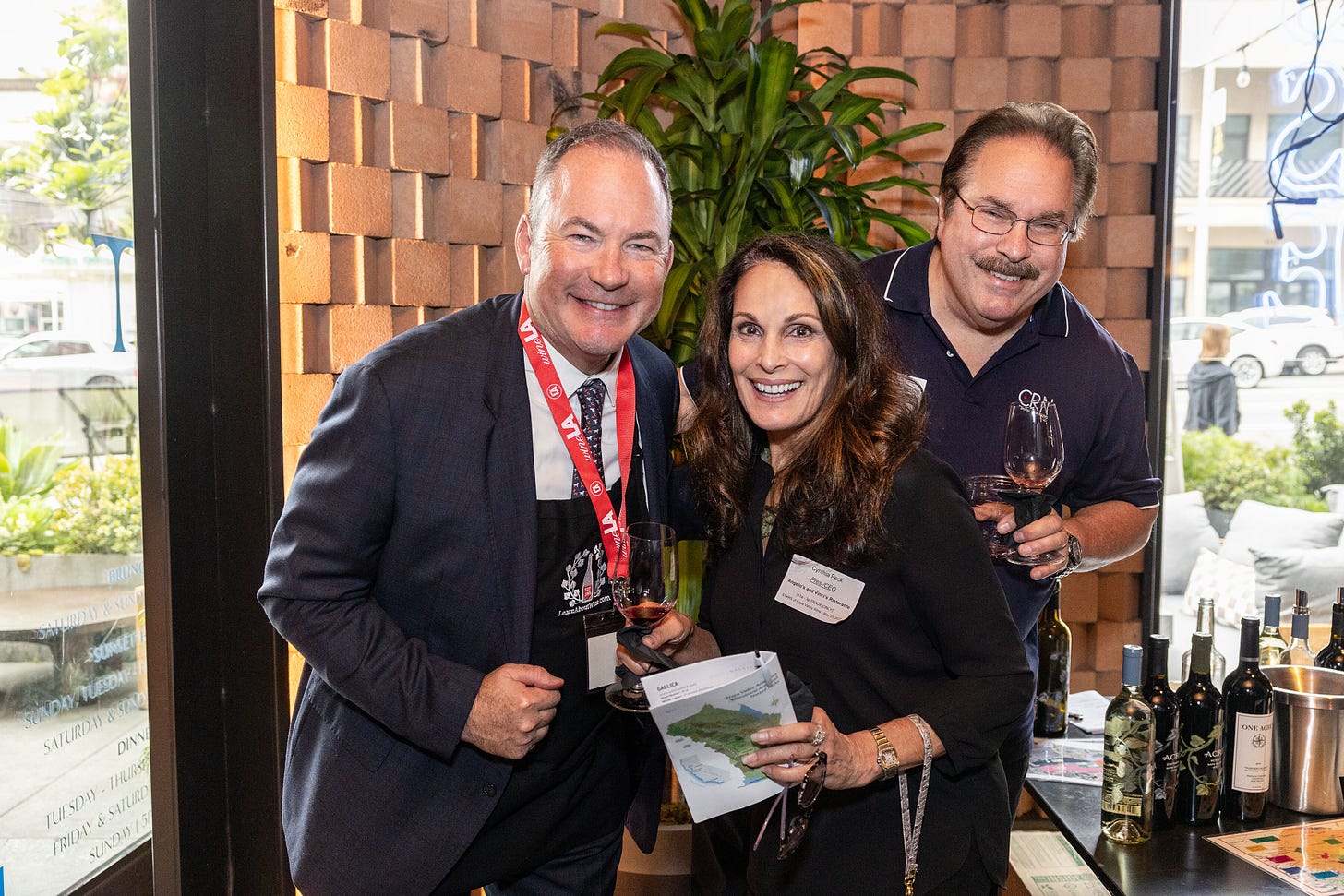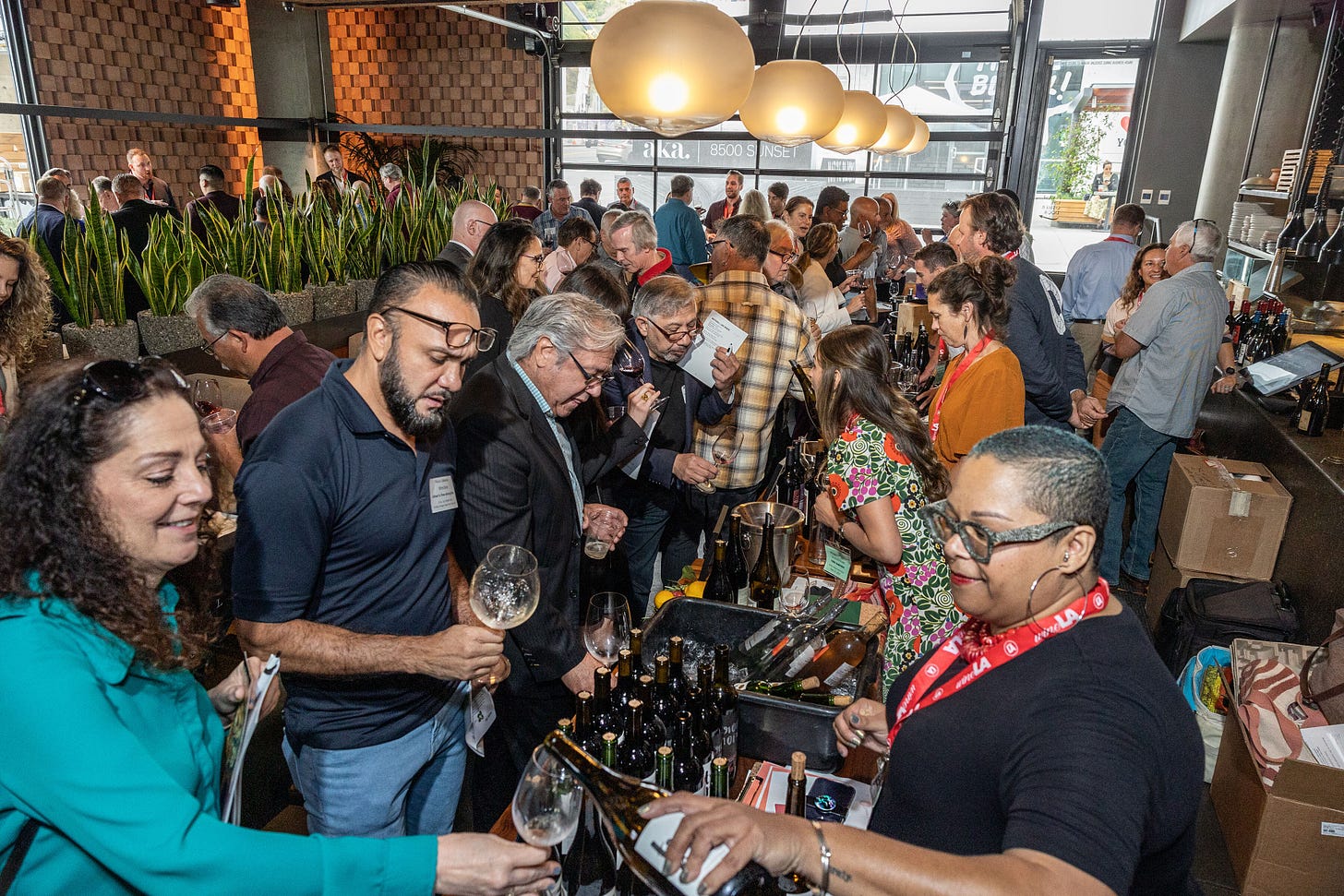NAPA VALLEY, Calif. — The Bay Area has its technocrats, but in Los Angeles — despite the growing bulkhead of Silicon Beach — entertainment still reigns supreme. While Hollywood and celebrity tastemakers impact wine consumption trends with discretionary income and the occasional “Walk in the Clouds” or “BottleRock,” the Los Angeles market is far more complex than many winemakers or wine marketers realize. Where does Napa Valley fit into contemporary, post-pandemic LA?

Industry veteran Ian Blackburn of Los Angeles’ Learn About Wine hosted a trade tasting on May 25 in conjunction with Napa Valley Vintners. The Stars of Napa Valley Wine tasting took place appropriately enough on Sunset Boulevard at Tesse restaurant, itself a venue that represents the upmarket LA dining scene. Tesse’s Executive Chef Raphael François and Pastry Chef Sally Camacho Mueller provided signature light bites above and beyond the typical trade tasting fare, and Boutellier/Tesse wine director and co-owner Jordan Ogron was on hand to assist participating wineries, as well.
A dynamic mix of approximately 175 attendees enjoyed the afternoon. They represented a robust cross-section of buyers, both seasoned and newbies, as well as journalists and other media reps. Some 25 wineries represented Napa Valley Vintners, successfully showcasing the region’s diverse appellations as well as its broad spectrum of grape varieties.
As wines were sampled and trade connections made, several key pieces of dialogue reverberated. One of these was necessarily a post-pandemic analysis. While direct-to-consumer (DTC) sales obviously surged during lockdown, marquee on-premise pours disappeared when said premises were shuttered. For wineries with robust pre-pandemic DTC channels such as wine clubs and successful SEO/eCommerce platforms, COVID-19 was an unprecedented boom. For wineries dependent on restaurant depletions, it was catastrophic. For distributors and brokers caught in the middle, the fallout is still being assessed. What does Napa now look like in Los Angeles?

Blackburn described his marketing challenges for Napa wines in a competitive market such as LA.
“To build an event that serves the needs of the visiting wineries, I am required to provide potential clients that will appreciate and participate in the purchase of wines,” he said. “While the price points are not for everyone, Napa Valley provides approximately 4% of the total volume of wine for the state of California. In a city of over 12 million people my challenge is to connect with that 4+%.”
He also remarked on consumers’ evolving relationship with Napa Valley, both as a wine-consumption category and a tourist destination.
“Napa continues to evolve away from the large corporate model associated with the industry of the past,” he said. “The replanting of the 1980s bears today’s fruit, fruit that continues to steer Napa toward truly being a cabernet kingdom. Napa continues to add elite amenities, and more people visit the valley today for dining than for the wineries. The wineries have transitioned to a DTC model and reward clients with VIP visitation and event offerings.”
Of this evolution toward luxury, he remarked that, “There are still enough wineries at every price point and enough producers of unique varieties, but the Napa market is clearly heading toward being considered the world’s most luxurious meeting and vacation destination.”
People and experiences may ultimately prove more valuable than that pricey cabernet juice.
Another key impact in the LA market has been the consolidation and/or acquisition of certain distributors. Some smaller players have disappeared entirely in these corporate transactions. Finding the right wholesale “fit” is one of the biggest obstacles in Los Angeles, particularly for wineries that may not understand just how horizontal the city is. It’s also critical to match production levels to distribution manpower. As a sommelier in the Los Angeles market, I have heard two common complaints from Napa winemakers over my years here: that the larger distributors expect larger brands to self-sell and that smaller distributors don’t have the legs to cover such a huge geographical area.

For Napa wineries looking to navigate the LA market, it’s important to break it down geographically as well as by placement expectations. Securing a high-profile, high-volume by-the-glass pour is usually 100% relationship-based, although price, of course, factors in. (We will not reference the Lakers tickets here.) But if you make limited quantities of wine, it’s important to plan ahead for where you think the wine should ultimately live for maximum ROI. The vastness of LA makes that very difficult, hence the continuing — if curious — rise of wine “influencers” as opposed to actual transactional buyers. A single bottle recommended to a large online following moves more cases than hitting the streets; it’s quite cost-effective, as any Instagram-fluent wine publicist will attest.
Mike Henry, co-owner of Acre Wines in Napa, brought his family’s small-production wines to the event at Tesse. When asked about the LA market, the veteran wine distributor-turned-winery owner had this to say.
“The biggest challenge in LA is getting in the door. Especially since 2020, restaurant and retail buyers are making fewer appointments, which makes it difficult to get placements. I am hopeful that there is a point of inflection where we can hit critical mass and start to grow our sales in LA exponentially, but at this point we are at the very beginning of that curve.”
On the “David and Goliath” aspect of marketing in the city, Henry replied with candor.
“To be perfectly frank, I wake up some mornings thinking that the Goliaths have already won, that the smaller wineries like ours should just fold up our tents and go home,” he said. “But then I remember all of the small wine shops and corner bistros who have tasted our wines, understood our story and fallen in love with the wine in the bottle. Those are the people we make our wine for, and as long as they exist, we’ll keep showing up and letting them know we’re still here.”
Also key to the Los Angeles market is the young hipster wholesale buyer and the surge of alternative low- or no-alcohol buying among millennials. Re the former, Los Angeles has been impacted by a zeal for “natural” wines often without an accurate understanding of the term. Conventionally made wines from well-known appellations (like Napa Valley, for example) seem less appealing than garagiste wines made naturally from wonky grapes sourced from wonky places. Cult cabernets from Napa are priced in line with aspirational disposable income; younger consumers and certain buyers yawn at that kind of trophyism. Similarly, younger Angelenos increasingly drink less wine (and less alcohol overall), as demonstrated by numerous studies.
As Rob McMillan, executive vice president and founder of Silicon Valley Bank’s wine practice, noted in the now-defunct bank’s 2023 industry report, “In my view, this is the greatest issue of concern for the wine business today — namely, the lack of engagement and participation in the wine category by younger consumers in their prime spending years.”
McMillan continued to suggest that, “whatever we are doing to promote brands to a younger consumer, I should argue we should stop right now because it’s not helping.”
Fingers can be pointed at White Claw and its kin, at the legalization of marijuana and at the wellness industry in general, but enticing younger consumers to buy expensive, appellation-branded wines is increasingly difficult.
Yet the thirst for certain Napa wines continues. Blackburn sees no bottoming out of the cult cabernet/brand-driven market among older consumers or those with discretionary spending power. Allocations are kind of like Oscars tickets in Los Angeles: They’re hard to get, but not THAT hard to get if you have money or know certain people.
At Otium restaurant in downtown LA, Wine Director Alyssa Shepherd sees Napa as essential but challenging. She remarked that, “Napa Valley holds a prestigious place on our list, and we are proud to offer producers like Harlan Estate, Bond and Abreu. We also keep a by-the-glass pour of Napa cabernet, as this tends to be requested quite a bit. I think guests buy Napa wines based on regionality.”
Shepherd occasionally sees DTC channels interfering with on-premise, noting that, “We have found that many of our guests belong to wine clubs from esteemed producers from Napa Valley. With waitlists years long and allocations at six to 12 bottles per year, these guests already have many of these wines in their cellar. As a result, when they do want to splurge on a bottle of wine, they tend to go to Burgundy or Bordeaux, so we find we aren't regularly selling many of the higher-priced Napa Valley wines.”
Big-volume producers with city-wide, comprehensive placements necessarily accrue brand loyalty. Certain (nameless) Napa brands now rely almost exclusively on mass accessibility, not inherent quality. Some consumers, particularly in chain restaurant or grocery store settings, will only buy what names they already know and once known, production amps up and quality goes down to maximize revenue. The long tail to this quality-blind consumer loyalty is disparagement among the cognoscenti, which is perhaps a synonym for “sommelier” or other overly educated folks in the wine trade.
Napa struggles to have it both ways, and it’s big enough to handle it. Napa now can mean tiny, handcrafted wines sold to discerning sommeliers as surely as it can mean trusted consumer-facing brands that are easy to make cheaply and in huge quantities. In LA, at least, it still seems you can have your Caymus and eat it, too.
Bonnie Graves, founder and president of Girl Meets Grape, a wine and lifestyle agency based in Los Angeles since 2005, defies expectations with her diverse background. Born in Salt Lake City and raised on the Jersey shore, Bonnie's passion for wine propelled her to become a sommelier after 15 years in the restaurant industry. Graduating magna cum laude from Harvard before reaching the legal drinking age, she combines her academic achievements with a penchant for collecting weird rocks and old maps. A multilingual enthusiast, Graves embraces her roles as a mother of two while nurturing her love for wine and a whole lotta latte. Her expertise extends beyond the personal sphere as she shares her knowledge and passion through Girl Meets Grape, helping others navigate the world of wine.





